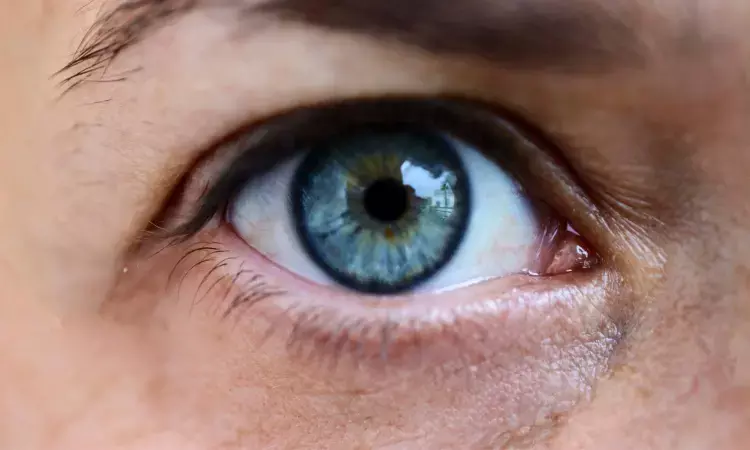- Home
- Medical news & Guidelines
- Anesthesiology
- Cardiology and CTVS
- Critical Care
- Dentistry
- Dermatology
- Diabetes and Endocrinology
- ENT
- Gastroenterology
- Medicine
- Nephrology
- Neurology
- Obstretics-Gynaecology
- Oncology
- Ophthalmology
- Orthopaedics
- Pediatrics-Neonatology
- Psychiatry
- Pulmonology
- Radiology
- Surgery
- Urology
- Laboratory Medicine
- Diet
- Nursing
- Paramedical
- Physiotherapy
- Health news
- Fact Check
- Bone Health Fact Check
- Brain Health Fact Check
- Cancer Related Fact Check
- Child Care Fact Check
- Dental and oral health fact check
- Diabetes and metabolic health fact check
- Diet and Nutrition Fact Check
- Eye and ENT Care Fact Check
- Fitness fact check
- Gut health fact check
- Heart health fact check
- Kidney health fact check
- Medical education fact check
- Men's health fact check
- Respiratory fact check
- Skin and hair care fact check
- Vaccine and Immunization fact check
- Women's health fact check
- AYUSH
- State News
- Andaman and Nicobar Islands
- Andhra Pradesh
- Arunachal Pradesh
- Assam
- Bihar
- Chandigarh
- Chattisgarh
- Dadra and Nagar Haveli
- Daman and Diu
- Delhi
- Goa
- Gujarat
- Haryana
- Himachal Pradesh
- Jammu & Kashmir
- Jharkhand
- Karnataka
- Kerala
- Ladakh
- Lakshadweep
- Madhya Pradesh
- Maharashtra
- Manipur
- Meghalaya
- Mizoram
- Nagaland
- Odisha
- Puducherry
- Punjab
- Rajasthan
- Sikkim
- Tamil Nadu
- Telangana
- Tripura
- Uttar Pradesh
- Uttrakhand
- West Bengal
- Medical Education
- Industry
Ocular Surface Disease may be manifestation of GERD

A new study published in Cornea suggests that there was an increase in prevalence of ocular discomfort in patients with GERD/LPR. Further the observations of vasoactive intestinal peptide (VIP) and neuropeptide Y transcripts demonstrate the potential neurogenic nature of the inflammatory state.
Common gastrointestinal illnesses with extraesophageal symptoms (EGERD) include gastroesophageal reflux disease (GERD) and laryngopharyngeal reflux (LPR). GERD/LPR and eye pain have been linked in studies. Antonio Di Zazzo and colleagues undertook this study to assess the incidence of ocular involvement among individuals with GERD/LPR, characterize clinical and biomolecular signs, and suggest a therapeutic plan for this unique EGERD.
This masked randomized controlled research included 53 LPR patients and 25 healthy controls. With a 1-month follow-up, fifteen naïve individuals with LPR were treated with magnesium alginate eye drops and oral treatment (magnesium alginate and simethicone tablets). A clinical eye surface examination, the eye Surface Disease Index questionnaire, tear sample, and conjunctival imprinting were all conducted. ELISA was used to measure tear pepsin levels. Imprints were subjected to immunodetection for human leukocyte antigen-DR isotype (HLA-DR) and transcript expression (PCR) for HLA-DR, mucin 5AC (MUC5AC), IL8, nicotine adenine dinucleotide phosphate (NADPH), vasoactive intestinal peptide, and neuropeptide Y.
The key findings of this study were:
When compared to controls, patients with LPR showed substantially greater Ocular Surface Disease Index (P 0.05), lower T-BUT (P 0.05), and higher meibomian gland dysfunction (P 0.001).
Tear break-up time (T-BUT) and meibomian gland dysfunction scores returned to normal following therapy.
Pepsin levels rose considerably in EGERD patients (P = 0.01) and dropped significantly after topical therapy (P = 0.0025).
HLA-DR, IL8, and NADPH transcripts were considerably higher in the untreated group compared to the controls, and similar significant values were found following therapy (P 0.05).
MUC5AC expression increased considerably with treatment (P = 0.005).
VIP transcripts were greater in EGERD than in controls and reduced after topical therapy (P 0.05). In NPY, no significant alterations were detected.
Reference:
Di Zazzo, A., Micera, A., Surico, P. L., Balzamino, B. O., Luccarelli, V., Antonini, M., Coassin, M., & Bonini, S. (2023). Ocular Surface Disease as Extraesophageal Gastroesophageal Reflux Disease Manifestation: A Specific Therapeutic Strategy. In Cornea. Ovid Technologies (Wolters Kluwer Health). https://doi.org/10.1097/ico.0000000000003329
Neuroscience Masters graduate
Jacinthlyn Sylvia, a Neuroscience Master's graduate from Chennai has worked extensively in deciphering the neurobiology of cognition and motor control in aging. She also has spread-out exposure to Neurosurgery from her Bachelor’s. She is currently involved in active Neuro-Oncology research. She is an upcoming neuroscientist with a fiery passion for writing. Her news cover at Medical Dialogues feature recent discoveries and updates from the healthcare and biomedical research fields. She can be reached at editorial@medicaldialogues.in
Dr Kamal Kant Kohli-MBBS, DTCD- a chest specialist with more than 30 years of practice and a flair for writing clinical articles, Dr Kamal Kant Kohli joined Medical Dialogues as a Chief Editor of Medical News. Besides writing articles, as an editor, he proofreads and verifies all the medical content published on Medical Dialogues including those coming from journals, studies,medical conferences,guidelines etc. Email: drkohli@medicaldialogues.in. Contact no. 011-43720751


